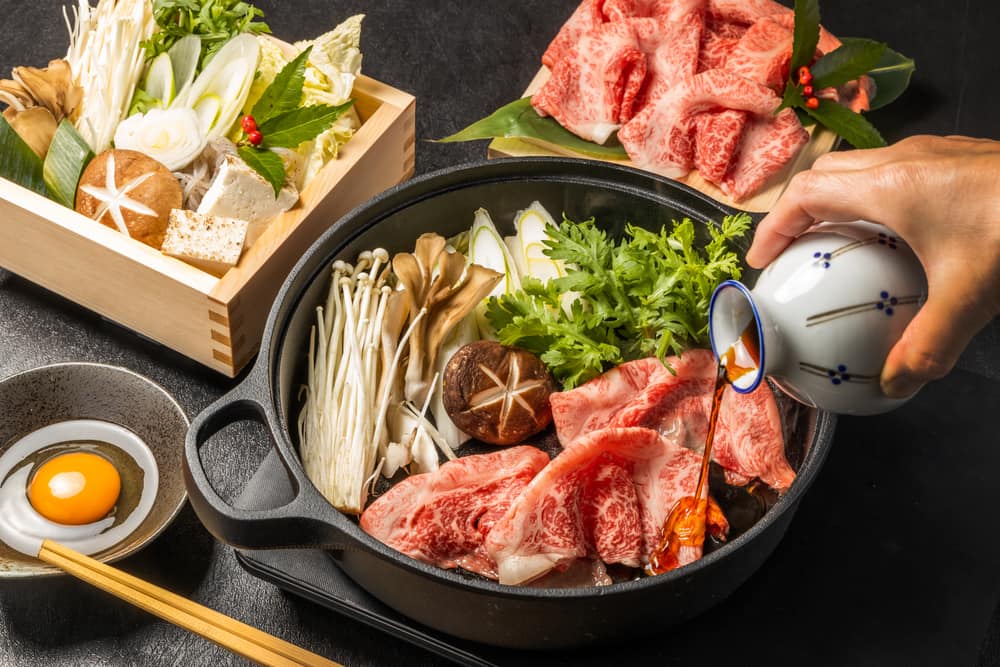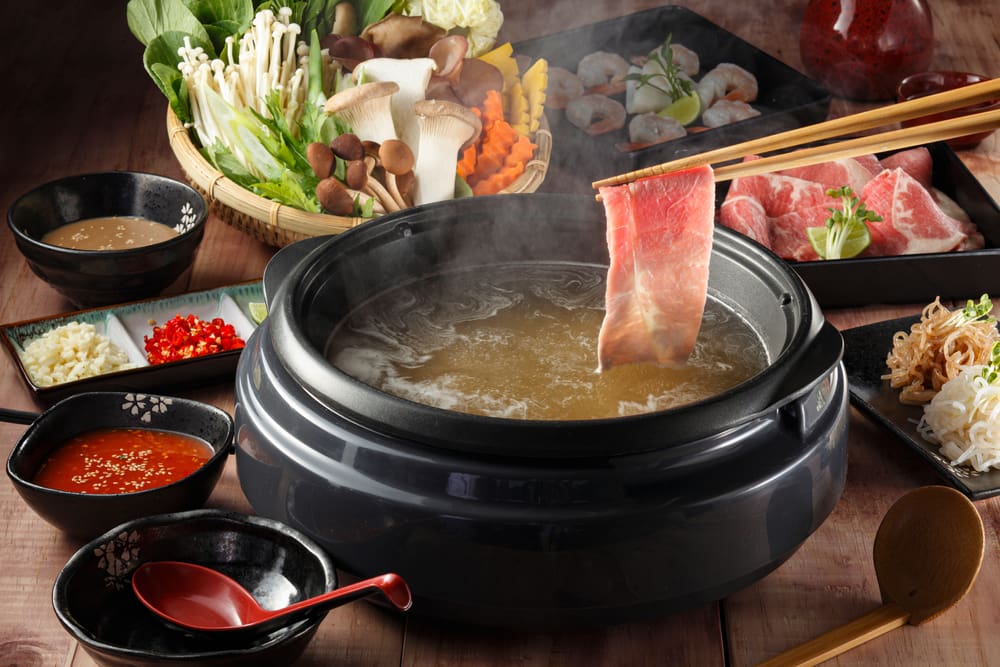
Sukiyaki and shabu-shabu are often favorites of those who enjoy hot, flavorful broth. But did you know that although these two dishes are similar winter favorites, they have clear differences? This article will guide you through the differences between sukiyaki and shabu and also recommend original Japanese-style sukiyaki and shabu restaurants near Chidlom Station that are a must-visit.
What is Sukiyaki?
Sukiyaki is a traditional Japanese hot pot dish consisting of meat, vegetables, and other ingredients simmered together in a hot pot. It features a richly flavored broth and is typically enjoyed with raw egg and a distinctive dipping sauce. Here are its unique characteristics:
Characteristics of Sukiyaki
- Cooking: Various ingredients, such as beef, pork, seafood, and fresh vegetables, like Chinese cabbage and shiitake mushrooms, are cooked together in a hot pot.
- Broth: The broth is minimal, just enough to cook the ingredients. It is not intended for sipping like a soup and typically includes dashi or a broth made from boiled bones mixed with soy sauce, sugar, and mirin.
- Eating: It is traditionally eaten with a raw egg, where the egg is beaten into the broth and used as a dip for the meat and vegetables.
- Dipping Sauce: Commonly served with ponzu (a citrus-based sauce) mixed with grated ginger, green onions, and wasabi.
The communal aspect of eating sukiyaki reflects the warmth, unity, and sharing culture of Japanese dining. Beyond the delicious flavors of the meats and vegetables, the experience of eating together enhances bonds and the enjoyment of the meal.
What is Shabu-Shabu?
Shabu-shabu (or shabu for short), originating as a variation of Japanese sukiyaki, is similar to Thai hot pot. The method of cooking shabu-shabu differs significantly in that, instead of simmering all ingredients together, meat slices and other ingredients are swished piece by piece in a pot of boiling broth.
The name “shabu-shabu” (しゃぶしゃぶ) in Japanese mimics the sound of the ingredients being swirled in the hot broth.
Characteristics of Shabu-Shabu
- Cooking: Ingredients are cooked piece by piece by swishing them in boiling broth.
- Broth: Typically uses a clear broth such as kombu (kelp), pork bone, or chicken broth.
- Eating: Accompanied by various dipping sauces like ponzu, sukiyaki sauce, light soy sauce, and sesame sauce.
- Ingredients: Commonly uses thinly sliced meats like beef, pork, chicken, seafood like shrimp and squid, various vegetables, tofu, and glass noodles.
With its savory flavors and leisurely dining style, shabu-shabu is a beloved Japanese dish recognized globally for producing a warm, convivial atmosphere.
What is the Difference Between Shabu and Sukiyaki?
While sukiyaki and shabu-shabu are both Japanese hot pot dishes that involve cooking meat and vegetables in broth, they have interesting differences:
| Differences | Sukiyaki | Shabu-Shabu |
| Broth | Sukiyaki uses a dark, sweet, and rich broth typically made from dashi mixed with white soy sauce, sugar, and mirin | Shabu-shabu uses a lighter, clear broth, often made from kombu or bone broths. |
| Dipping Sauces | Sukiyaki is typically enjoyed with raw egg and ponzu. | Shabu-shabu can be enjoyed with a variety of sauces, including ponzu, sukiyaki sauce, light soy sauce, and sesame sauce. |
| Cooking Method | Sukiyaki cooks all ingredients together in less broth, focusing on the richness of the sauce. | Shabu-shabu involves swishing thin slices of meat and vegetables one at a time in more broth, which can be sipped. |
Differences in Broth
- Sukiyaki: Utilizes a rich, sweet broth, commonly made with dashi, white soy sauce, sugar, and mirin, giving it a robust flavor.
- Shabu-Shabu: Features a clear, savory broth often made from ready-made kombu or broths from pork or chicken bones.
Differences in Dipping Sauces
- Sukiyaki: Typically eaten with raw egg mixed with ponzu, garnished with grated ginger, green onions, and wasabi.
- Shabu-shabu: Offers a variety of dipping sauces such as ponzu, sukiyaki sauce, light soy sauce, and sesame sauce.
Differences in Cooking Methods
- Sukiyaki: All ingredients are cooked together in a pot with a small amount of rich broth, which is not usually consumed as a soup.
- Shabu-Shabu: Ingredients are cooked individually by swishing them in ample broth, which can be enjoyed as a soup.
Recommended Sukiyaki and Shabu Restaurants in Downtown
1. KAGONOYA SHABU
Kagonoya Shabu is renowned for its broth, simmered for 48 hours using beef bones, which infuses it with a deep, sweet flavor, maintaining the authentic aroma and taste of the beef. The restaurant uses high-quality beef imported from Japan, offering a delicate and rich taste. The interior is decorated in a traditional Japanese style, simple, clean, and cozy, creating a relaxing atmosphere.
- Recommended Menu Items: Mixed beef set, special sliced pork Kurobuta set, and a mixed seafood set including shrimp and abalone.
- Starting Price: 549++ THB for a 1.5-hour dining experience
2. Mongkok Sukiyaki
Mongkok Sukiyaki offers a unique experience by blending sukiyaki and shabu styles together, offering a rich, sweet sukiyaki broth and four different types of shabu broth. Ingredients are fresh and of high quality, ranging from meats to seafood and vegetables, in a modern yet warm setting, ideal for enjoying a hot broth.
- Recommended Menu Items: Marbled beef sukiyaki set, Kurobuta pork shabu set, and a mixed seafood set. They have over 200 items, including snacks and desserts.
- Price: 646 THB net for a 1.5-hour dining experience.

Now that you know how sukiyaki and shabu differ, if you’re eager to taste these delicious dishes, you don’t have to go far. Just stop by Mercury Ville, where you’ll find top sukiyaki and shabu places to eat in the Chidlom area. Explore some of the best and most popular restaurants near Chidlom BTS station at our mall.



